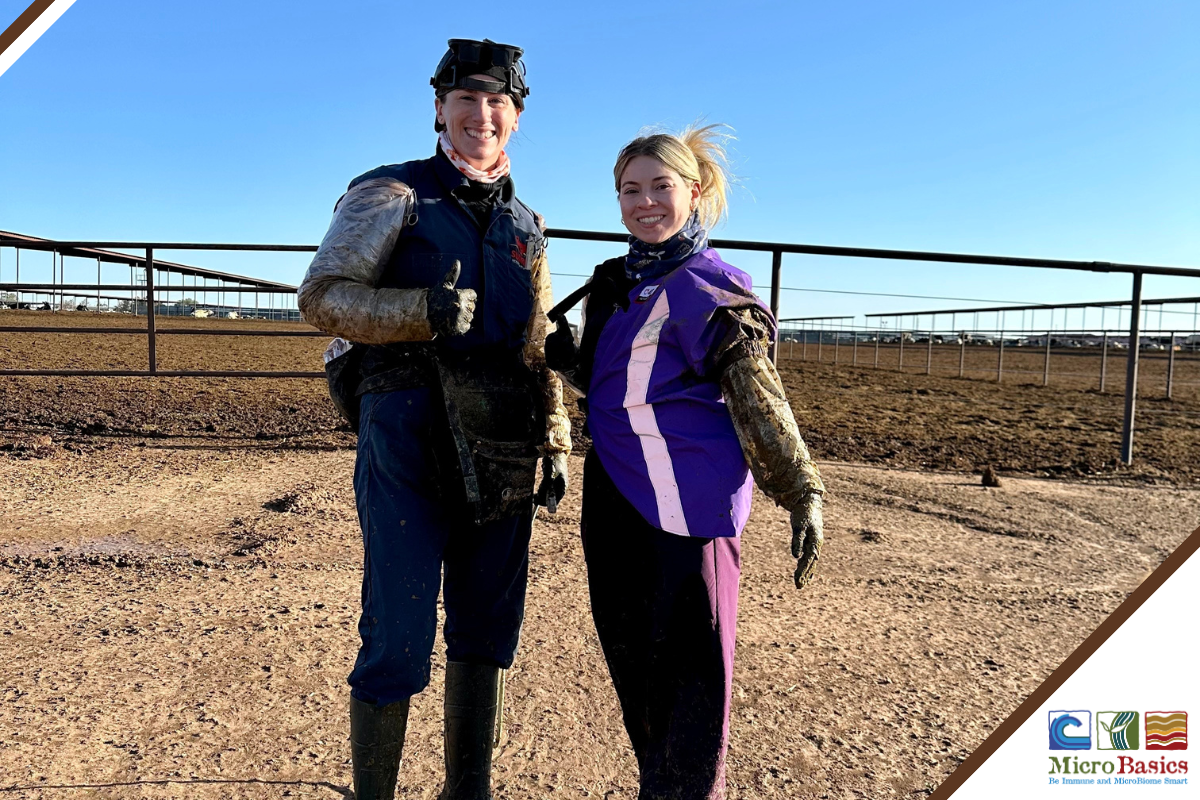This week we get to hear some thoughts on dairy cattle health from Dr. Petersen of Sunrise Veterinary Service. Dr. Petersen is originally from Eastern Iowa and jokes she did her whole career backwards. In 2009 she graduated from veterinary school at Iowa State University and began her first job with the USDA in a slaughterhouse in the Central Valley of California. She spent a year in regulatory medicine and then she joined a private practice in Tulare, CA.
“In a large practice, all the younger associate veterinarians were everyone else’s relief,” notes Dr. Petersen. “We had many clients, but there were few that I had the opportunity to visit more than one time. I wanted to have one on one relationships with the farms that I work with, and to get to know the people taking care of cows so I could build relationships with those crews. I attended a continuing education meeting and met a veterinarian from the Texas Panhandle. He asked if at some point I would be interested in joining him in the Panhandle, and I did the following year. I worked for him for one year branched out independently after that time. Four years ago, I took a break from clinical practice and worked in the pharmaceutical and technology industry. I rekindled my private practice formally last year.
At the end of the day, the biggest difference I can make is to have my boots on the ground with individuals that are able to make decisions. While I am grateful for the experience I had working in industry and technical services, I feel I can make a stronger impact locally with the dairy industry.”
Dr. Petersen brings a well-rounded perspective to herd management. Here are a few things she has to say about dairy management.
What management aspect is often overlooked in dairy herds?
I am fortunate to work with owners and managers who are very hands on. Something I think that gets overlooked, on the size and scale of dairies that I work with, is that you have layers of specialized individuals, and those layers support and supervise employees that may have less specialization or experience. From the top down, the farms that I see the most engagement on are those that when the owner or manager askes someone on their team to do something, and they themselves know how to do it and can demonstrate how to do it, the person completing the job, project, or task is way more likely to be successful at completing it. Additionally, follow-through is much more effective because the owner or manager can quickly verify that the work has been done correctly and be available for follow up.
A second aspect that ties into the first is to be able to communicate clearly. Having additional language skills, even if just some key words and phrases, really opens up these relationships. Like many in the dairy industry, I learned to speak Spanish via a combination of classes, apps, immersion, and lots of patient coworkers.
What are the biggest health concerns you encounter in dairy herds in the Texas Panhandle?
At times the challenges we face are procedurally dependent, and other times they are seasonally dependent. Some of the dairies that I work with raise their own heifer and dairy beef crossbred calves on site all the way through to milking or to the feedyard. Often times, what I see are very straight forward animal husbandry opportunities. How is the milk being pasteurized and mixed? Is it being done consistently? How are procedures being handled in maternity with colostrum handling and feeding? When a heifer freshens, what happens during her first few visits to the parlor? How are we detecting mastitis, and caring for calves, heifers, and cows that get sick?
This late spring and summer, it has been quite wet in the Panhandle this year. We have ongoing challenges with udder health and hoof health when cattle are standing and lying in a wet environment. The moisture has also caused a lot of insects to hatch and fly around. So, we have pressure from several types of flies and gnats in the corrals, which causes the heifers and cows to bunch up, spend more time standing up than lying down, be more irritated when they are handled, and there has been some sporadic pinkeye as well.
What issues have you witnessed this season?
This year we had a really late wheat harvest, and delayed corn planting. We won’t see those effects now, but we will see them once we begin to feed our wheat crop and in the future with the corn crop.
Those are the things we are thinking about now. We had been in a drought, so we had a lot of challenges getting enough forage. Now we have the opposite, and we are having trouble harvesting what we need when we planned, as well as getting the next crop in the ground.
There are a whole variety of housing types in this part of the world. At the end of the day, it is important to ensure you have the right environment for the animal. Our open lot pens with shades have been put to the test with all the moisture, and we have managed many cases of mild to severe mastitis. We usually bed pre-weaned calves with sand in the summer, but it has been so wet we had to go back and straw the hutches! You would not expect that here in the summer months.
What tools have you used to help correct those problems?
At wheat harvest some of the wheat ended up much more mature than expected. The fields were so wet that we couldn’t get in there to chop it. We tried baling some. We even tried going after the seed, which isn’t something we would normally do.
As far as fly control we have implemented anything and everything. I really tip my hat to my clients as they have aggressively removed wet manure, box bladed, and harrowed. They’re making sure that pens are getting dried, soft bedding regularly and getting rid of stagnant water. Slashing weeds, spraying weeds, using feed through fly control, predator wasps, spraying surfaces and cattle, and putting out fly traps. All the above!
Nobody really knows how corn harvest is going to turn out right now, but my clients and I will sit down with their nutritionists and review our ongoing ‘battle plan’, and then the rubber will hit the road when harvest happens.
What management practices could producers implement to avoid or reduce health problems?
Probably the most straight forward forms of animal husbandry are where I love to start with dairy owners and their teams. It is really all about setting goals for the cow’s environment, for her nutrition, and evaluating what is normal or abnormal for her health.
There is a term called normalization of deviance. An example would be that I grew up on a dairy farm, and I envision something that is abnormal as normal because we have always done it that way, or I have seen other people do it that way. As a team we need to define what is normal and the procedures we need to take to keep the animals well cared for.
What resources would you like to see more available to dairy producers?
First off, I think something that can be helpful to all producers is having a group of peers you are comfortable talking with about what is happening on your farm, learning from each other, and supporting one another during tough times. Many are already doing this with family, neighbors, and friends.
Secondly, prioritize goal setting and benchmarking on your farm. We do that already with our bankers and our nutritionists, but it’s important to formalize those goals we already have in mind.
A lot of my farms keep track of data in a couple of different ways. It’s finding a way to maintain that data specific to that farm and understand the drivers behind each metric. As much as the peer opportunities are great, it’s important to focus on what is feasible on your specific farm.
The last thing is follow through. I love having another set of eyes on the dairies that I work with. But what’s most important is that if we make a change, what is the outcome? We must monitor when we make changes so that after a few weeks or a few months we can go back and evaluate if that change had the outcome that we thought it would. That means having a group of trusted advisors to work with. Connecting with allied dairy industry colleagues is also a big deal.
How can farms use industry standards to evaluate individual performance?
A big one for veterinarians is continuing education. We get to go and geek out about what’s new and what people are trying, and what current research shows us. Veterinarians get quite excited to work with dairy clients who want to continuously improve every day.
Day to day though, we know dairies can ‘break a lot of rules’ – meaning flex the standards – and be very successful. I challenge my farms to rethink what the standards should be for them, often times much higher standards (lower incidence of disease, higher ADG/weaning weights, etc. than industry dictates) and believe we should redefine what success looks like to them.
Insanity is the definition of doing something over and over and expecting a different result. It is difficult to refocus, because everyone gets very focused on the daily tasks of feeding, milking, breeding, moving cattle and so on, but we need to step back and see the whole picture. I want to know who the outlier individuals are and why they are different. We should constantly be looking for opportunities and challenge our conventional norms.
Thank you, Dr. Petersen, for sharing your insight into dairy management! We appreciate the influence you have in your area and on the dairy industry as a whole!
Written by: Mariah Gull, M.S.

